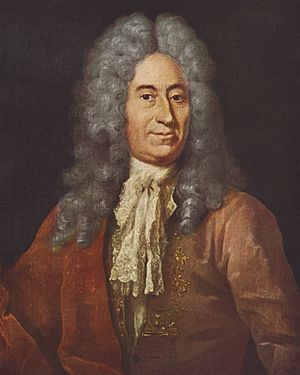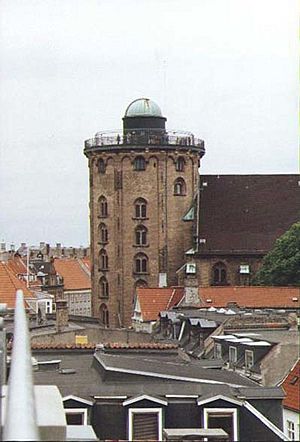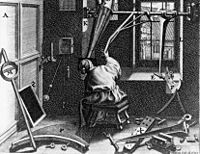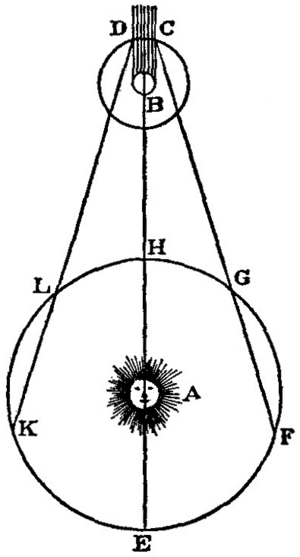Ole Rømer facts for kids
Quick facts for kids
Ole Rømer
|
|
|---|---|

Ole Rømer, portrait by Jacob Coning from c. 1700
|
|
| Born |
Ole Christensen Rømer
25 September 1644 |
| Died | 19 September 1710 (aged 65) |
| Nationality | Danish |
| Alma mater | University of Copenhagen |
| Known for | Rømer's determination of the speed of light Rømer scale Cycloid gear Light-time correction Altazimuth mount Meridian circle |
| Scientific career | |
| Fields | Astronomy |
| Signature | |
Ole Christensen Rømer (born September 25, 1644 – died September 19, 1710) was a famous Danish astronomer. In 1676, he made the very first measurement of the speed of light.
Rømer also created an early version of the modern thermometer. This thermometer showed temperature using two fixed points: where water boils and where it freezes.
Sometimes, you might see his name spelled differently, like "Roemer" or "Römer".
Contents
Biography

Ole Rømer was born in Århus, Denmark, on September 25, 1644. His father, Christen Pedersen, was a merchant and sailor. His mother was Anna Olufsdatter Storm.
In 1662, Rømer finished school at the Aarhus Katedralskole. He then moved to Copenhagen and joined the University of Copenhagen. His teacher there was Rasmus Bartholin. Rømer lived in Bartholin's home and learned a lot about mathematics and astronomy. He even helped prepare Tycho Brahe's old astronomy notes for publishing.
Later, Rømer worked for the French government. King Louis XIV made him a teacher for his son, the Dauphin. Rømer also helped build the amazing fountains at the Palace of Versailles.
In 1681, Rømer returned to Denmark. He became a professor of astronomy at the University of Copenhagen. That same year, he married Anne Marie Bartholin, who was Rasmus Bartholin's daughter. He observed the stars from the University Observatory at Rundetårn and from his own home. He even built better tools for his observations. Sadly, most of his notes were lost in the great Copenhagen Fire of 1728. But his assistant, Peder Horrebow, later wrote about Rømer's work.
As the royal mathematician, Rømer created the first national system for weights and measures in Denmark in 1683. This system helped make sure everyone used the same measurements. He wanted to base these measurements on natural constants, like a pendulum, but that happened after his death. He also defined a new Danish mile.
In 1700, Rømer convinced the king to start using the Gregorian calendar in Denmark-Norway. This was something Tycho Brahe had tried to do a hundred years earlier without success.
Rømer also created one of the first temperature scales. He did this while recovering from a broken leg. In 1708, Daniel Gabriel Fahrenheit visited him. Fahrenheit later changed Rømer's scale, which led to the Fahrenheit temperature scale we still use today in some countries.
Rømer also helped set up navigation schools in several Danish cities.
In 1705, Rømer became the Chief of the Copenhagen Police. He held this job until he died in 1710. One of his first actions was to fire the entire police force because he felt their morale was very low. He invented the first street lights (oil lamps) in Copenhagen. He also worked hard to help control the poor and unemployed people in the city.
As police chief, Rømer made rules for building new houses. He fixed the city's water supply and sewers. He also made sure the fire department had new and better equipment. He was a key person in planning and making new pavement for the streets and city squares.
Ole Rømer died at age 65 in 1710. He was buried in Copenhagen Cathedral.
Rømer and the Speed of Light
Figuring out longitude (your east-west position) was a big problem for mapmakers and sailors. Galileo suggested using the eclipses of Jupiter's moons as a "cosmic clock" to tell time. This method was hard to use on ships, but it worked better on land.
In 1671, Rømer worked with Jean Picard to watch about 140 eclipses of Jupiter's moon Io. They observed from an island near Copenhagen. At the same time, Giovanni Domenico Cassini watched the same eclipses from Paris. By comparing their observation times, they could figure out the longitude difference between the two places.
Cassini had noticed strange things in his earlier observations of Jupiter's moons. He thought it might mean light travels at a certain speed, not instantly. In 1672, Rømer joined Cassini in Paris and kept observing Io. Rømer noticed that the time between Io's eclipses got shorter when Earth moved closer to Jupiter. It got longer when Earth moved farther away.
Cassini seemed to give up on this idea, but Rømer kept working on it. He used observations from 1671 to 1677. Rømer shared his findings with the French Academy of Sciences. An article about his work was published in 1676, but it was a bit confusing. Rømer himself never published his results.
Here's how Rømer thought about it: Imagine Earth is at point L (see the picture), and Io comes out of Jupiter's shadow at point D. After several orbits of Io, Earth moves to point K. Rømer realized that if light doesn't travel instantly, it would take extra time for the light to reach K. He estimated this delay to be about 3.5 minutes. This delay explained why the eclipses seemed to happen later when Earth was farther away.
Rømer used a table of his observations from 1676 to support his idea. He found that the delay could be as much as 22 minutes when Earth was on the opposite side of its orbit from Jupiter. This 22-minute delay was the time it took for light to cross the entire diameter of Earth's orbit around the Sun.
| Month | Day | Time | Tide | orbits | average (hours) |
|---|---|---|---|---|---|
| May | 12 | 2:49:42 | C | ||
| 2,837,189s | 18 | 41.48 | |||
| June | 13 | 22:56:11 | C | ||
| 4,748,019s | 31 | 42.54 | |||
| Aug | 7 | 21:49:50 | D | ||
| 611,765s | 4 | 42.48 | |||
| Aug | 14 | 23:45:55 | D | ||
| 764,718s | 5 | 42.48 | |||
| Aug | 23 | 20:11:13 | D | ||
| 6,729,872s | 44 | 42.49 | |||
| Nov | 9 | 17:35:45 | D | ||
Rømer didn't actually calculate the exact speed of light himself. But many others used his data to do so. The first was Christiaan Huygens. After talking with Rømer, Huygens figured out that light traveled about 212,000 kilometers per second.
It took a while for everyone to accept that light had a finite speed. This idea was fully accepted after James Bradley made more measurements in 1727.
In 1809, another astronomer, Jean Baptiste Joseph Delambre, used Io's observations again. By then, observations were much more precise. He reported that light took 8 minutes and 12 seconds to travel from the Sun to Earth. This calculation gave a speed of light just over 300,000 kilometers per second. Today, we know the exact value is 299,792.458 kilometers per second, and it takes about 8 minutes and 19 seconds for sunlight to reach Earth.
There is a special plaque at the Observatory of Paris. It remembers Rømer's work, which was the first time anyone measured a universal constant on Earth.
Inventions
Besides the first street lights in Copenhagen, Rømer also invented several important astronomical tools:
- The meridian circle: This helps measure the exact position of stars.
- The altazimuth: This allows telescopes to move up-down and side-to-side.
- The passage instrument (or transit instrument): Another tool for measuring star positions as they cross the sky.
Ole Rømer Medal
The Ole Rømer Medal is a special award. The Danish Natural Science Research Council gives it out every year for amazing scientific research.
The Ole Rømer Museum
The Ole Rømer Museum is in Denmark, at the place where Rømer's own observatory, Observatorium Tusculanum, once stood. This observatory opened in 1704. It was used until about 1716, when the tools were moved to Rundetårn in Copenhagen.
The museum opened in 1979. It has a large collection of old and new astronomy tools. Since 2002, it has been part of the Kroppedal museum at the same location.
Honours
Ole Rømer has been honored in many ways in Denmark:
- His picture has been on bank notes.
- A hill, Ole Rømer's Hill, is named after him.
- There are streets named after him in Aarhus and Copenhagen.
- Aarhus University's astronomical observatory is called The Ole Rømer Observatory in his honor.
- A Danish satellite project, which aimed to study stars, was named The Rømer Satellite. However, this project was never completed.
- The Römer crater on the Moon is also named after him.
See also
 In Spanish: Ole Rømer para niños
In Spanish: Ole Rømer para niños



